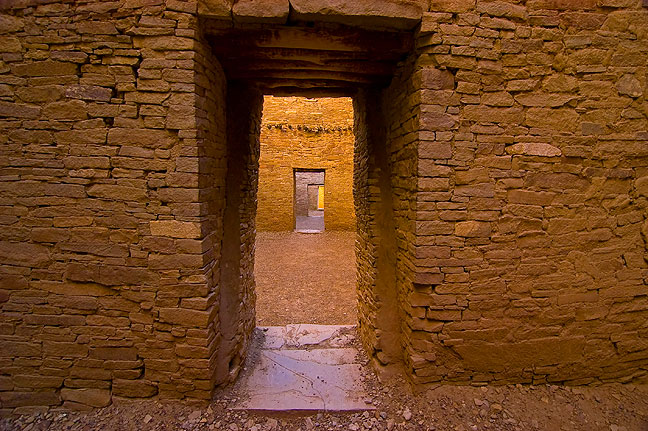

Driving to Albuquerque
As always, the long ribbon of interstate 40 asphalt west proved an interesting drive. My first stop was at Amarillo, where I spotted the fact that the Cadillacs at Stanley Marsh’s Cadillac Ranch were yellow. I’ve stopped plenty of times at the Cadillac Ranch over the years, so I wasn’t planning to stop, but I’d never seen them yellow. Some volunteers from Lance Armstrong’s LiveStrong Foundation were painting them to raise cancer support. It made some neat images, and it was a unique opportunity. Also in Texas, I stopped to shoot a storage building that was painted with a farm scene, a sight I’d seen over and over, but only now stopped to photograph.
By the time I got to New Mexico, the light, which wanes quickly in November, was starting to fade. I wanted to photograph a particularly colorful rock outcropping on the north side of the highway, but I couldn’t remember exactly where it was, so I took a guess about which exit to take. I was right, and also ran into a very lovely abandoned church in Newkirk, New Mexico, which was soaking up some very nice late afternoon light. The outcropping didn’t work out the way I wanted it to because the access road is actually lower than the highway, so I didn’t really have a good shot at it. Next time.
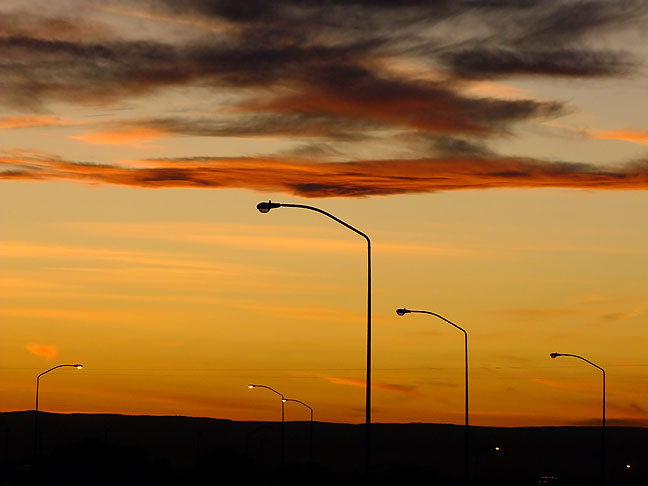
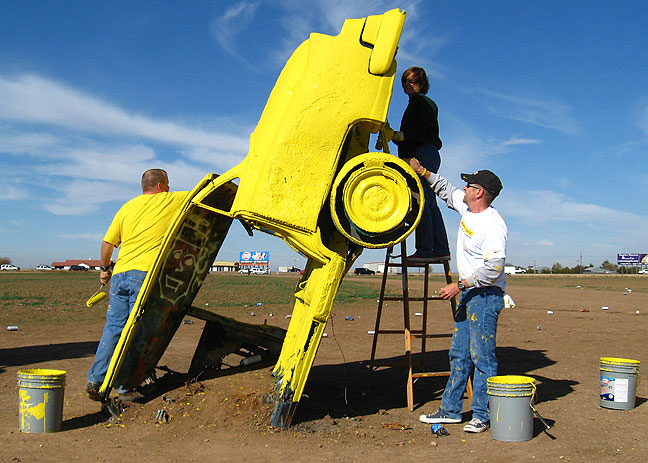
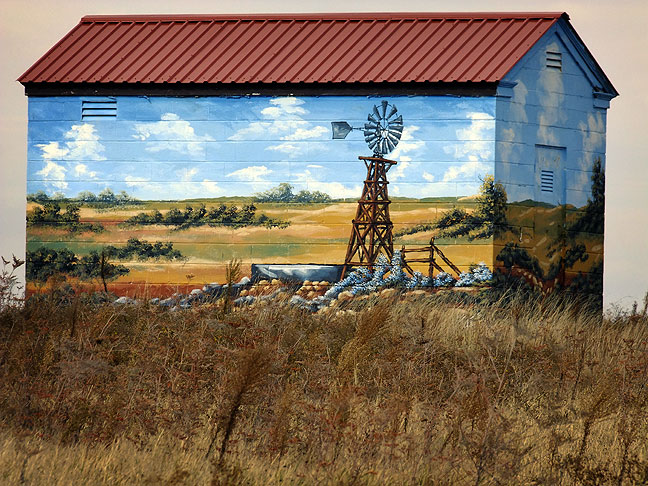

U. S. 550, Pueblo Alto trail, Chaco Overlook trail


I was up before dawn in Albuquerque, and on the road to Chaco Culture National Historical Park, one of my favorite places to camp and hike.
I saw dozens of interesting first-light possibilities, but just made mental notes about one day spending the day along this stretch of road, U. S. 550. I stopped a couple of times, but I think this stretch of desert deserves more time than I had.
My destination was Chaco, which I hadn’t seen since 2003. I decided that I wanted to hike all the trails at Chaco, and when I arrived, I started with one of my favorites, the 5.6-mile Pueblo Alto trail. It leads up the north rim of Chaco Canyon to two great houses, Pueblo Alto and New Alto, and also leads to a short spur trail overlooking the largest Chacoan great house, Pueblo Bonito. On my hike, I didn’t see anyone else.
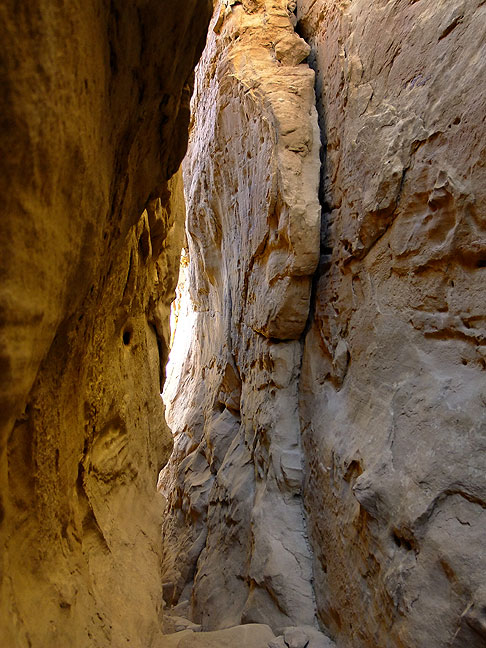



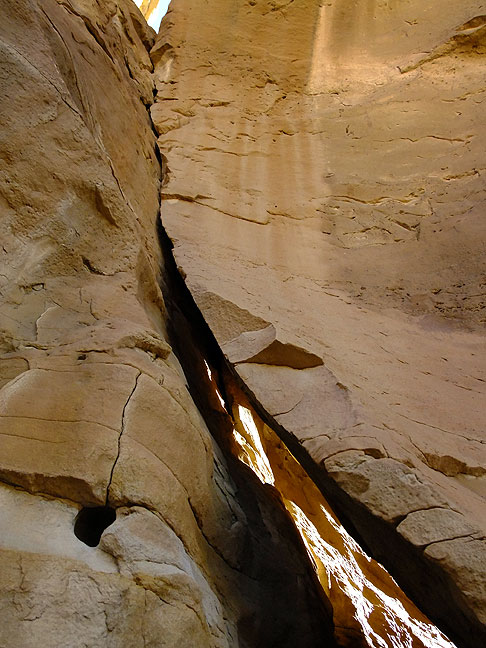




After setting up my camp site in the Gallo Campground and making a late lunch of vegetable soup and tortillas, I hiked the Chaco Canyon Overlook trail, which is full of interesting geology, some small natural arches, and an excellent view of Fajada Butte and Chacra Mesa. I saw another hiker, who was going back and forth. She told me it was her favorite trail in the park.
I also photographed a large trail cairn that sits right at the top of the switchbacks at the start of the trail. In 2003, it was U-shaped, but since then hikers have filled it in. The image I made of it six years ago was one of my favorites from that trip, and it was nice to see it again and photograph it again.
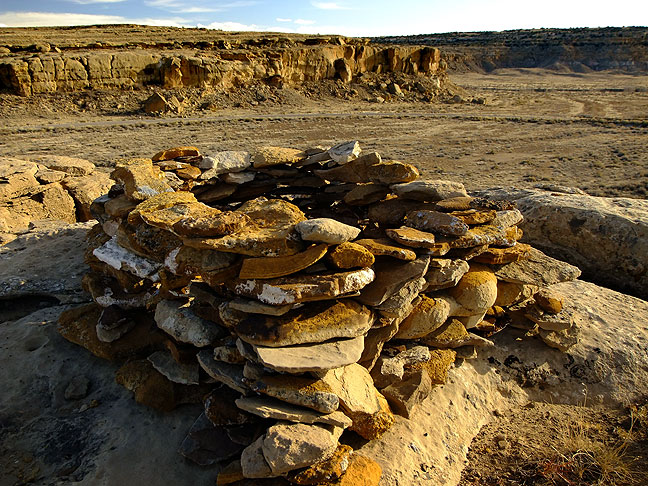


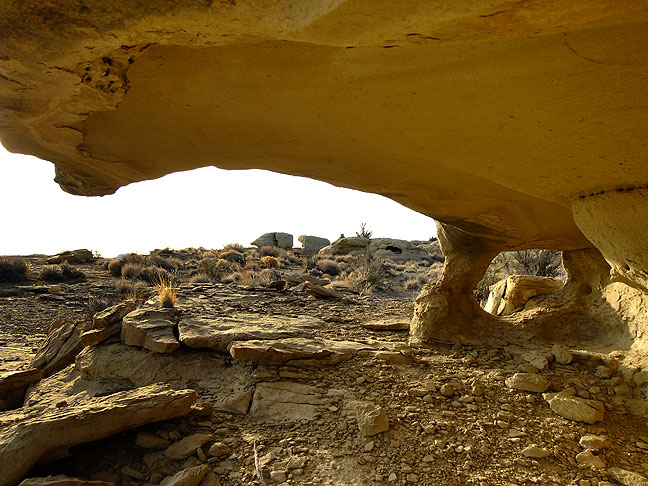
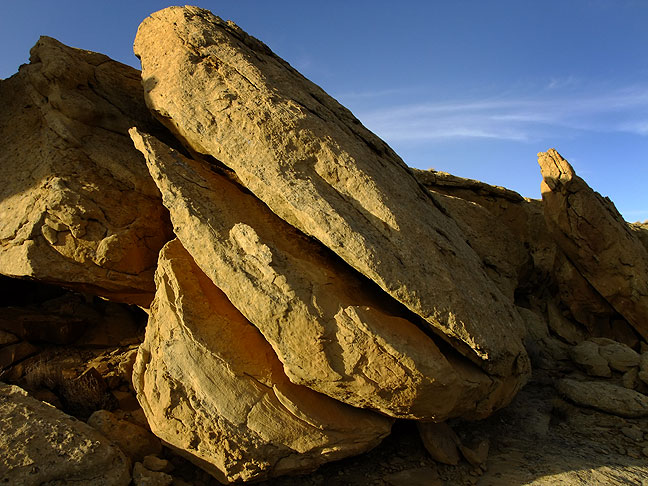

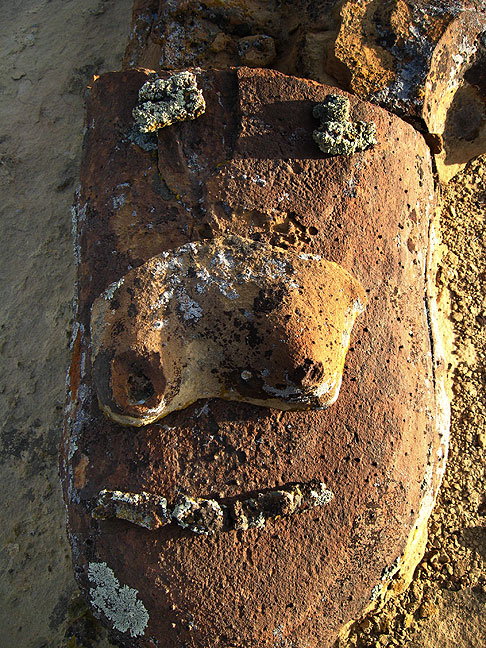

It was dark by 5 pm, so I settled in for an evening in front of my camp fire. I brought several DuraFlame logs, since they are easy to light and last long. I also had my catalytic propane heater, which I put under my camp chair. By the time I was ready to sleep, it was quite cold, with a forecast low of 23.


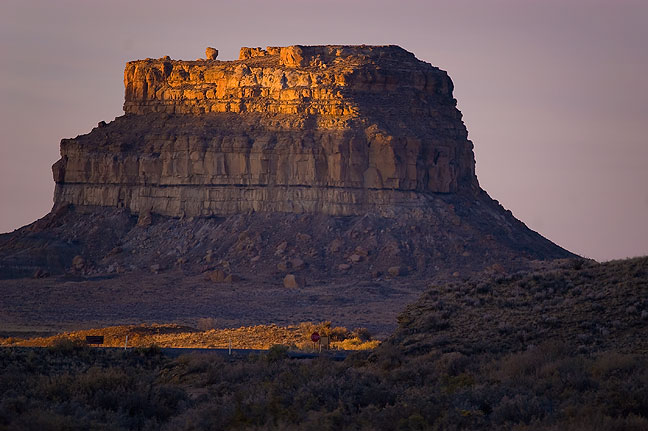
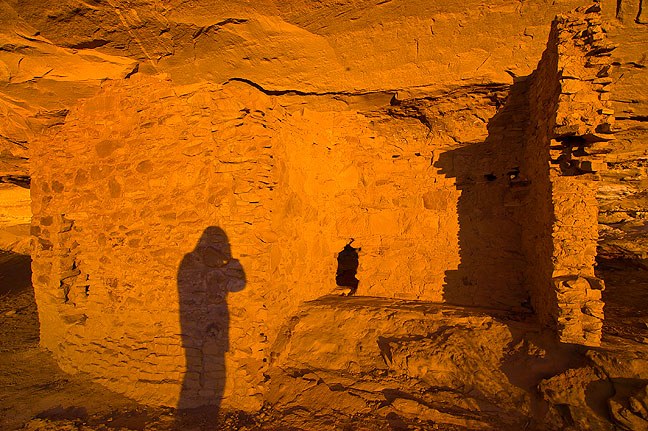
South Mesa, Wijiji, Pueblo Bonito
I photographed Fajada Butte at first light from the Gallo Campground. I also walked over to the Gallo Cliff Shelter and squeezed off a couple of frames.

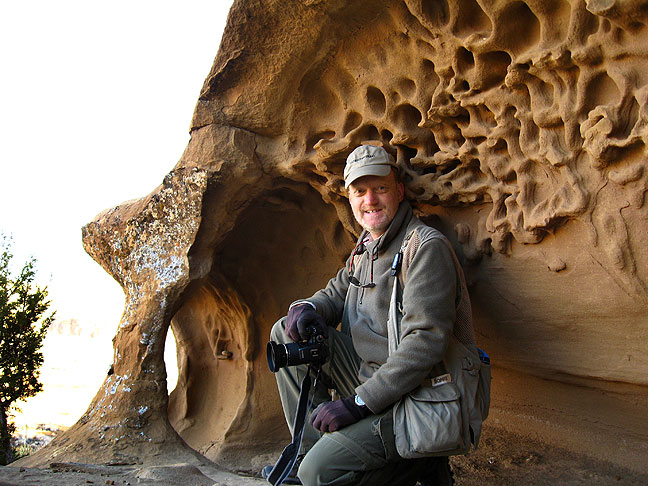
My first trail was the South Mesa, which leads to a partially excavated Chacoan great house called Tsin Kletsin. The ruins are only mildly interesting, but the trail cuts through a very evocative swath of lonely, high-desert land. From the top of the mesa, you can see across the canyon to Pueblo Alto and New Alto.
As with most trails at Chaco in November, I didn’t see anyone else. It’s odd; though the trails are clearly marked and landmarks are always visible, I always feel lost at Chaco.




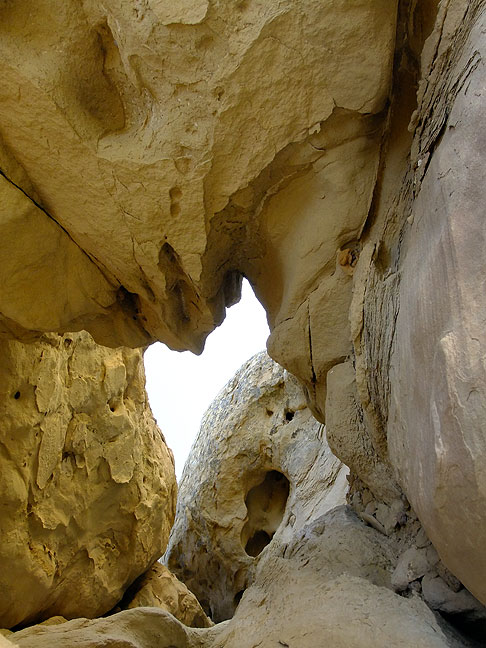

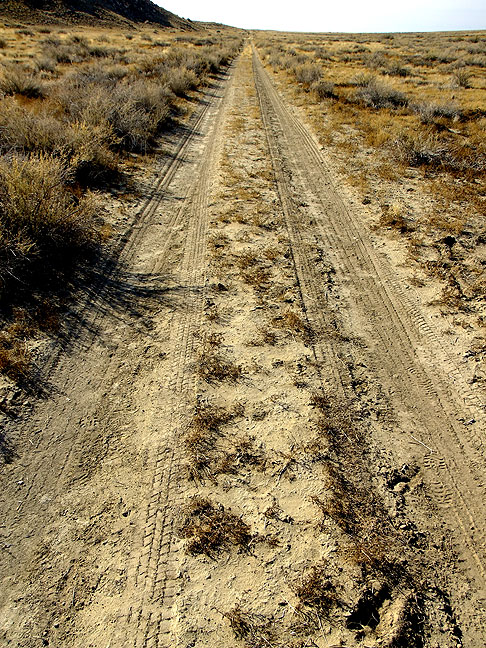

After an early lunch, I hiked the Wijiji Trail, the only trail on the east side of the park. It is another oddly lonely stretch. According to a park service person, the Navajo consider it evil for some reason.
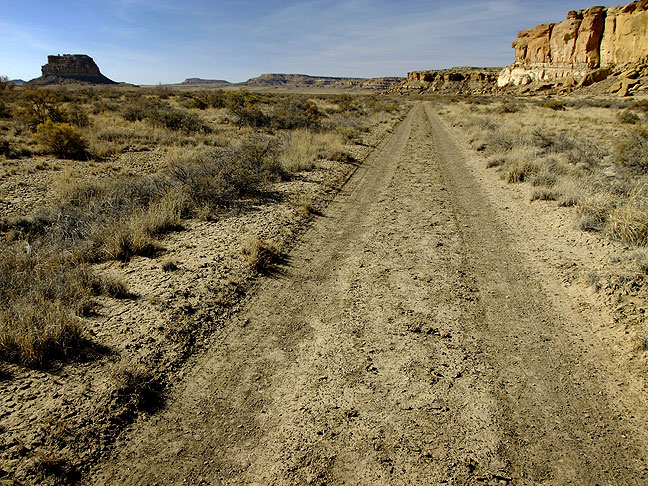
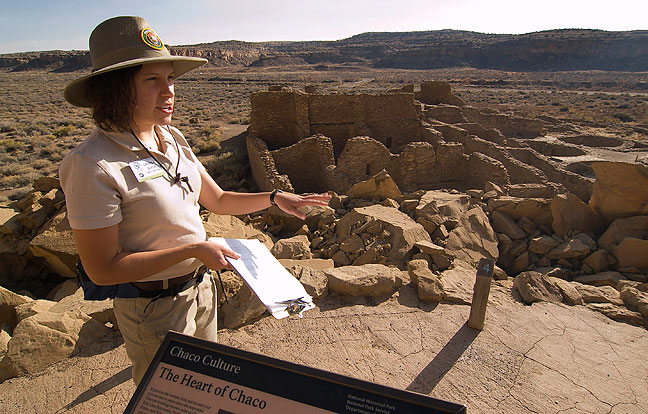
In the afternoon, I went to the visitor center, where I saw the girl who was hiking on the Chaco Overlook trail the day before; a volunteer ranger with the Student Conservation Association named Lauren Blacik, who invited me to take her tour of Pueblo Bonito at 2 pm. I took her up on it, and ended up enjoying it very much, and learning some things I didn’t know before. Lauren was enthusiastic and well-versed on the details of her tour. She had me take a picture of her with her camera for her family, explaining that she had been a ranger for one month.
One of my goals in taking the tour was to find and photograph some of the impressive Chacoan stone masonry doors I have seen in so many photographer’s portfolios of Chaco.
I wanted to photograph them myself, and we found them and photographed them. I was very pleased with the result.
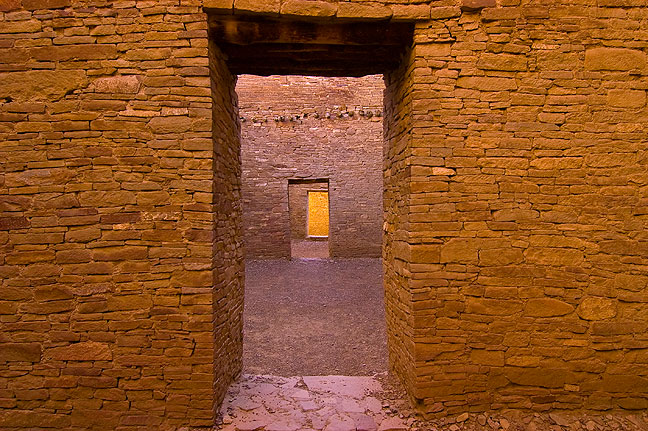





Back at the visitor center I overheard a woman asking if she could buy firewood anywhere, so I offered to give her a couple of my DuraFlame logs, since I had plenty.

We struck up a conversation, and she told me that she was Maria, she lived in Santa Fe, and told me, “I’m just exploring. I haven’t been to Chaco in over 20 years.” She had a bike and was planning to ride all she could at Chaco. She also said she had just spent three nights at the De-Na-Zin Wilderness nearby. She wanted to give me $10 for the fire logs, but I would only take $5. The next morning I gave her two more logs, since I was done camping and she wasn’t.
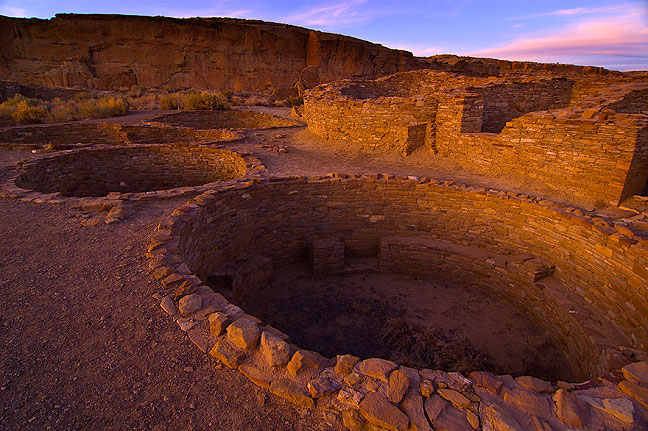
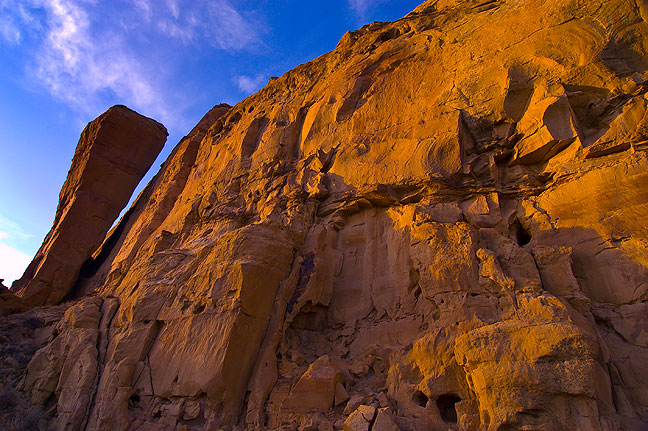

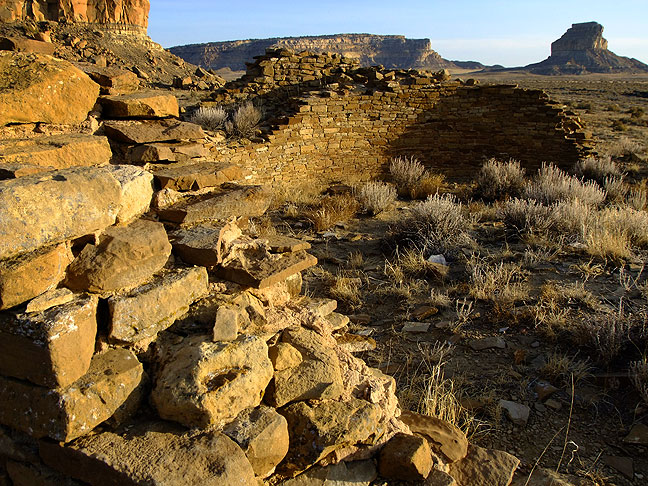
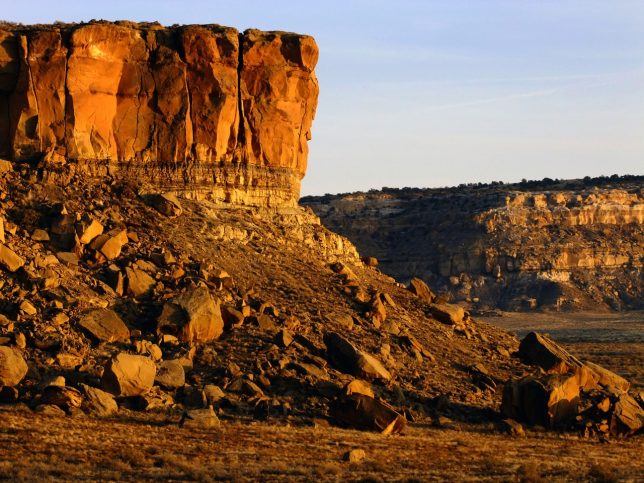

Dark brought another cold night in the Gallo Campground, and I decided it would be a good night, clear and still, to photograph the night sky. On the advice of a fellow outdoor photographer who makes a lot of star trace images, I decided to shoot a number of relatively short-exposure (30 seconds) images and stack them together in Photoshop, a technique that minimizes the noise associated with very long exposures with digital sensors. After some reading on the web, I was able to stack 60 images, resulting in a nice 30-minute star trace photo looking southwest.
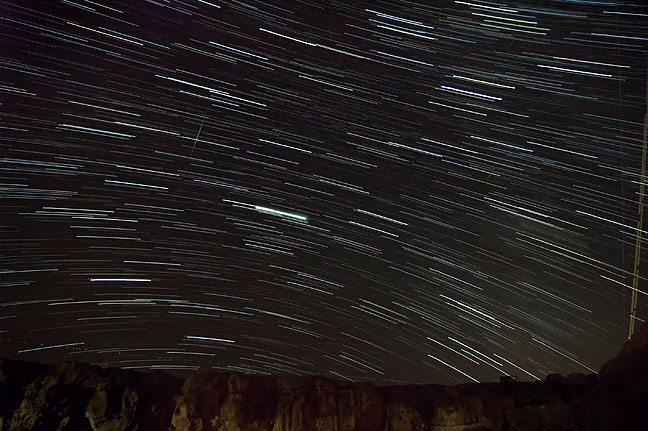
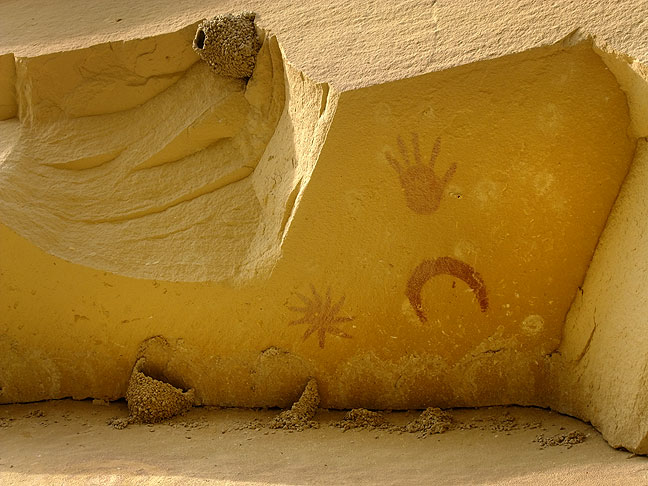
Peñasco Blanco, Angel Peak, Aztec Ruins, and Anasazi Arch
I broke camp early in Chaco, and hit the last trail in the park, Peñasco Blanco, which passes the famous Supernova platograph, thought to represent the supernova of 1054 AD. Again, I didn’t see anyone else on the trail. There are several great houses along this route, and some very interesting petroglyph panels along the trail. A long trail that crosses the Chaco wash near the west end of the park, this route affords views of its namesake, the Peñasco Blanco great house, for much of the way.
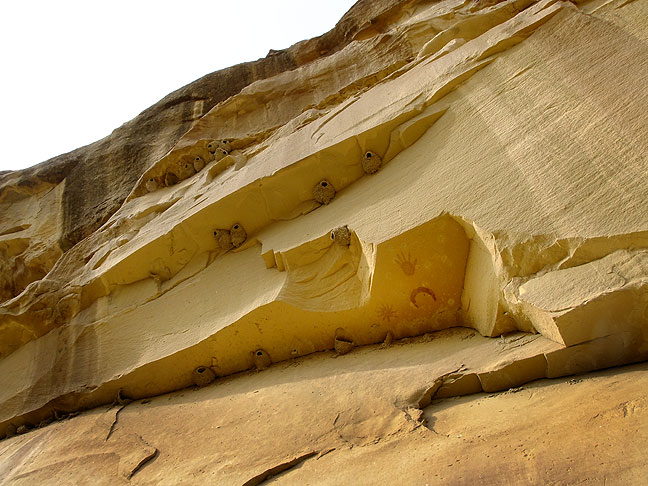
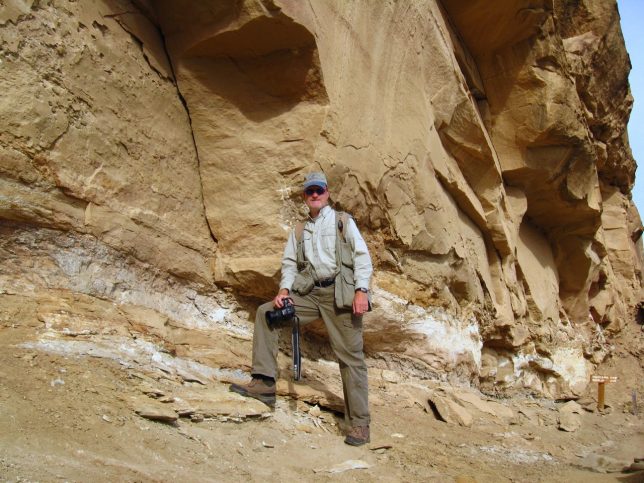
With all the trails at Chaco under my belt, I drove north to U. S. 550, then headed northwest to spend the night in Farmington, New Mexico.
Along the way I stopped briefly at Angel Peak, which we visited in 2003, to see if anything had changed. The site was essentially unchanged, with just a few more gas and oil wells visible. It has been renamed, however; it is now the Angel Peak Scenic Area; six years ago it was the Angel Peak National Recreation Area.


I made a few passable frames, but since I wasn’t hiking, and had gotten lots of really great stuff in 2003, I decided to drive on.
My next stop was Aztec Ruins National Monument, where I wanted to rephotograph the reconstructed Great Kiva. I was always disappointed in my result six years ago, and wanted to try again. I thought I knew how I wanted to reshoot it, and shot it that way, but also made a fisheye view, and that ended up being my favorite.
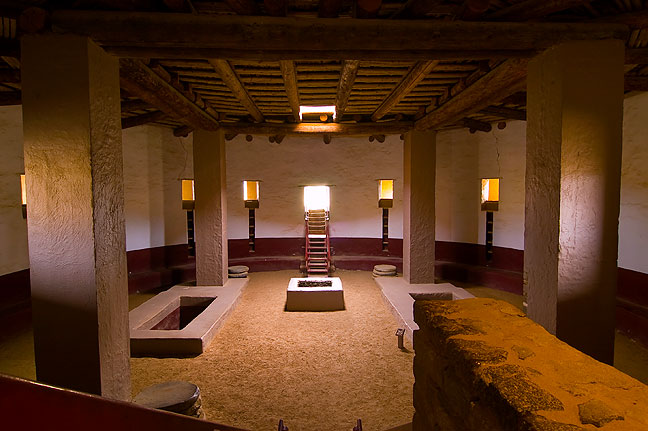
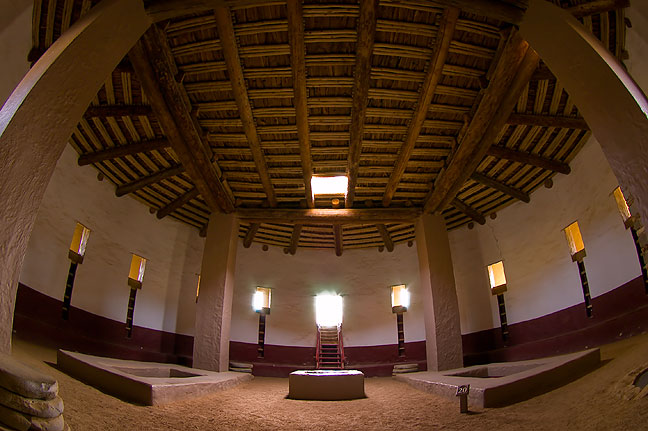
My next stop was just up the road from Aztec. The rangers at Aztec gave me a map of local arches, and I wanted to find and photograph the largest of them, Anasazi Arch.

The brochure had GPS coordinates, so I plugged them in, and my GPS got me close enough that I could figure out the rest. Getting to the arch after parking involved a bit of cliff scrambling, and some route finding, but in the end wasn’t overly difficult. Among other things, I could hear the hum from the oil rig pumping station below, so I could always follow the sound if I felt lost. It was obvious from the beer cans and tire tracks in the area that it was a party hangout at night. The arch itself is impressively big and beautiful.

Finally, I settled in to a motel room in Farmington for the night.
Bisti Wilderness, El Morro, and driving to Tucumcari
One item I wanted to be sure to see and photograph on this trip was the Bisti Wilderness Area, about 35 miles south of Farmington, New Mexico. Aside a short day hike in 2001, I haven’t seen enough of this huge, alien landscape.
In 2001, we hiked east and then north into an interesting area of eroded towers and washes, but I wanted to see something different this time, so I struck out directly east, then bent southeast as I followed the Bisti Wash. I came across some very interesting fields of hoodoos, as well as some excellent eroded bentonite hills. Despite the fact that the light was stubbornly subdued by a veil of high clouds, I felt I was still able to shoot some very interesting stuff.
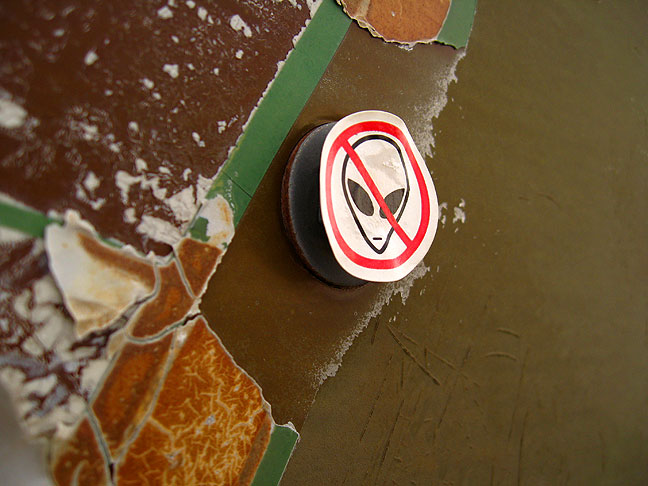
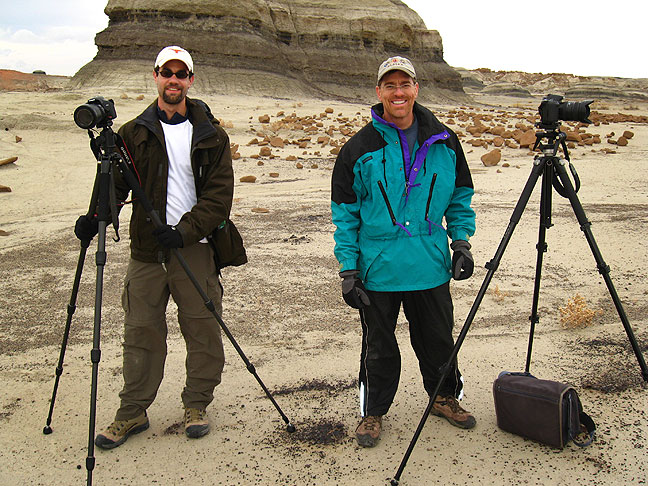
While I was exploring, I topped a red hill to sort out where I wanted to go, and spotted a tent and two figures who appeared to be people taking pictures. I made my way that direction, and approached and asked, “I’m looking for a formation called the ‘Cracked Eggs.’ Do you know where I could find it?”

“It’s right here!” they explained. We talked for a while, and they told me they were Steve and Chris from Albuquerque, and that they had come just for a couple of days to make a few pictures. The night before, they made some light-painting photos of the Cracked Eggs while they camped.
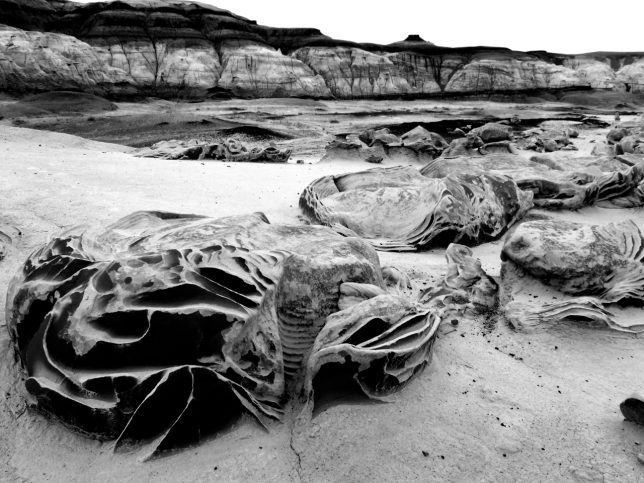

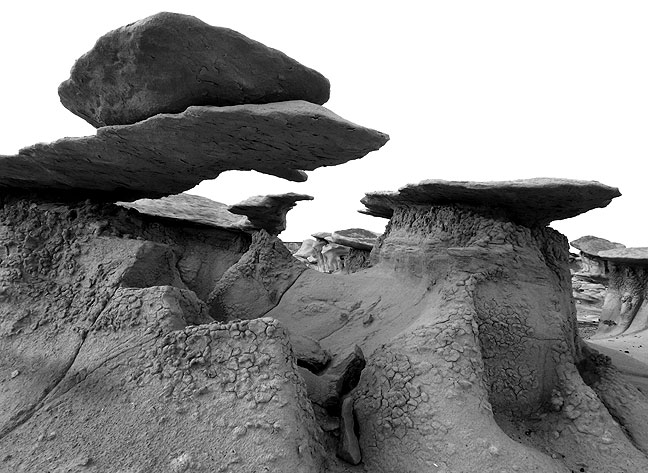


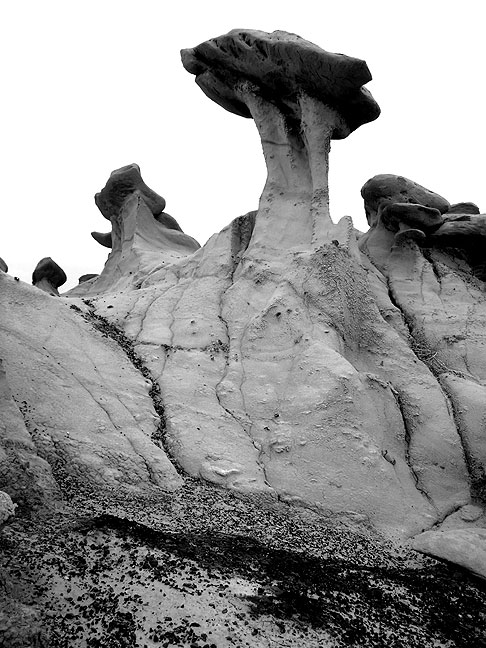
Since the light wasn’t cooperating, I decided to hike out around mid-day. I looked at a map for something that might be an interesting afternoon stop, and saw El Morro National Monument to the south. In 2000, I tried to visit it, but was too late in the day, so it was closed. This time, however, I would be there right after lunch, and I would be able to hike any short trails they offered.


I was surprised and delighted by the one trail, the Headland Trail, at El Morro.
It leads first past the reason for its significance, a large pool of water that stays full all year, which many years ago allowed travelers to stop and fill up on their journeys to explore the west. One result of this was “Inscription Rock,” the next item on the trail, which shows hundreds of historical messages carved into the stone. The trail continues up and around these amazingly beautiful sandstone towers past a large, oddly-structured natural arch called “Woodpecker Rock”, and leads around a spectacular box canyon, then past a Mogollon ruin. I was surprised that all this was hidden here, and glad I came.


The Drive Home
The drive home from Tucumcari is usually fairly uneventful, but on this occasion, I wanted to give another look to the Cadillac Ranch, to see if the yellow they had painted five days earlier was still there. Sure enough, the graffiti, part of the life of the Cadillac Ranch, had come back. It was pretty amazing, actually.
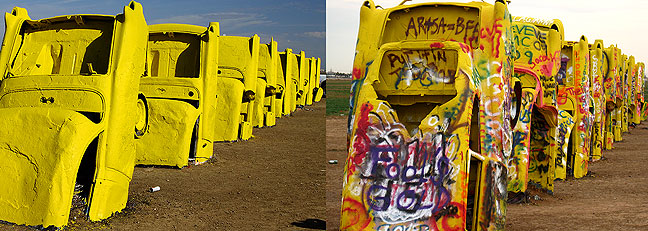
It was another excellent excursion out west, and from the moment it was over, I was planning the next one.
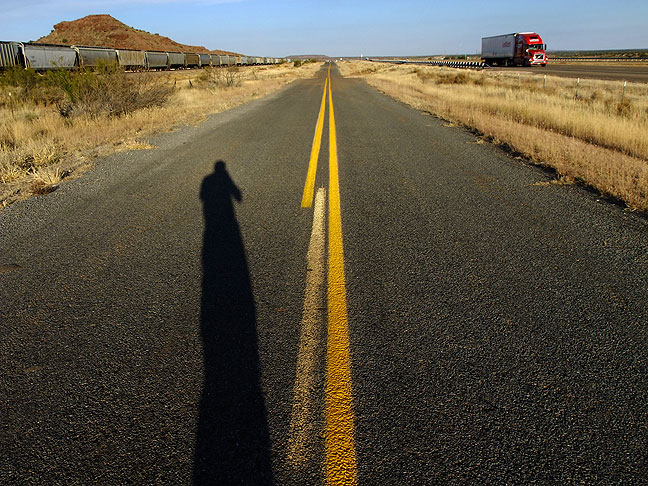
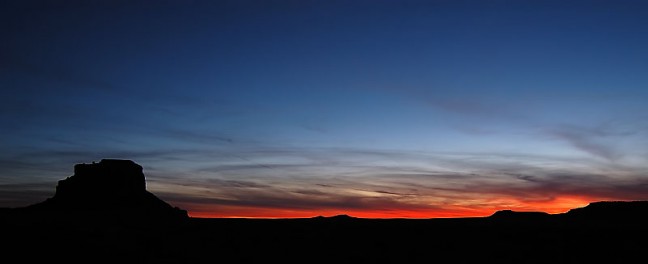
Thanks for allowing me the pleasure of your pictures. I was able to dream about being there. I would love to see these places in person but with my health it is highly doubtful that I will ever be able to. I love your attention to details. The small things ended up grabbing most of my attention. Thank you again for taking me on your journey.